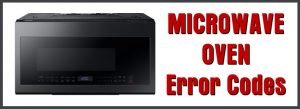
Now, you might be wondering, “What on earth does E1 mean?” Well, in the world of Samsung microwaves, this error commonly points to a problem with the humidity sensor. This sensor plays an important role by determining whether the microwave’s cooking or reheating cycles are doing their job correctly. If this little sensor starts giving incorrect readings or fails altogether, the microwave gets confused and triggers the E1 error to let you know there’s an issue. But don’t worry, understanding this problem is the first step toward fixing it.
Understanding the Samsung Microwave Error Code E1
So, what’s really happening when you see that E1 code? In simple terms, it’s all about communication—or rather, the lack of it. The humidity sensor in your microwave is like a weather forecaster inside the appliance. Its job is to measure the moisture level inside the cooking chamber. When you’re heating food, the steam from your meal tells the sensor how the cooking’s going. But if the sensor can’t communicate these moisture levels effectively to the microwave’s brain (the control board), the E1 error code shows up.
Think of it like trying to watch a movie with a pair of broken headphones. The movie might be playing perfectly, but if the sound isn’t getting to you, you’re left in the dark. Similarly, the microwave’s control system relies on accurate sensor readings to function properly. If the sensor is confused or not working, it’s like those broken headphones—you’re missing the complete picture. Fortunately, just like you might replace your headphones or check the connection, there are ways to address the E1 error.
Common Causes of E1 Error in Samsung Microwaves
One of the main culprits behind the E1 error is, unsurprisingly, a faulty humidity sensor. Over time, sensors can wear out or simply fail, much like a favorite pair of shoes that eventually needs replacing. If the sensor is no longer detecting the correct moisture levels, it can cause errors in cooking times, leading to that pesky E1 code. Replacing the sensor is often the best solution in this scenario, and while it might sound complex, it’s usually a straightforward process for a professional.
Another possible cause is the sensor’s wiring. Picture the sensor as a messenger trying to deliver a letter. If the roads (or wires) it takes are damaged or disrupted, the message might never arrive at its destination. Similarly, if the wires connecting the humidity sensor to the control board are damaged or loose, the microwave might not get the correct information, triggering the E1 error. Ensuring these connections are secure can sometimes solve the problem without needing to replace the sensor itself.
Lastly, sometimes the control board—the microwave’s brain—might be the root of the issue. This part of the microwave could be misinterpreting the signals from the humidity sensor. It’s like having a friend who mishears everything you say; even if you’re speaking clearly, the message isn’t getting through correctly. In such cases, resetting the microwave or, in rare situations, replacing the control board can resolve the problem. But let’s be honest, that’s often best left to the experts.
Steps to Resolve E1 Error and Prevent Future Occurrences
If your microwave is flashing E1, don’t panic! A simple reset could work wonders. Unplug the microwave for a short period—say, ten minutes. This is like rebooting your computer when it’s acting up. After letting it rest, plug it back in and see if the error persists. If the code disappears, it might have been a temporary glitch, and you can let out a sigh of relief.
However, if the E1 error stubbornly remains, checking the sensor connections is a logical next step. Ensure that there are no loose or damaged wires. This simple check can sometimes save you a call to the repair technician. And if you’re feeling brave (and have unplugged the microwave for safety), you might even inspect the sensor itself. If it looks visibly damaged, it’s time to consider a replacement.
In the future, regular maintenance can keep E1 errors at bay. Keeping the microwave clean prevents residue buildup, which can interfere with sensor readings. Also, handling the door gently prevents misalignment that could stress the sensor. Treat your microwave with the same care you’d show to any trusted kitchen appliance, and it’s likely to serve you well without unexpected E1 surprises.